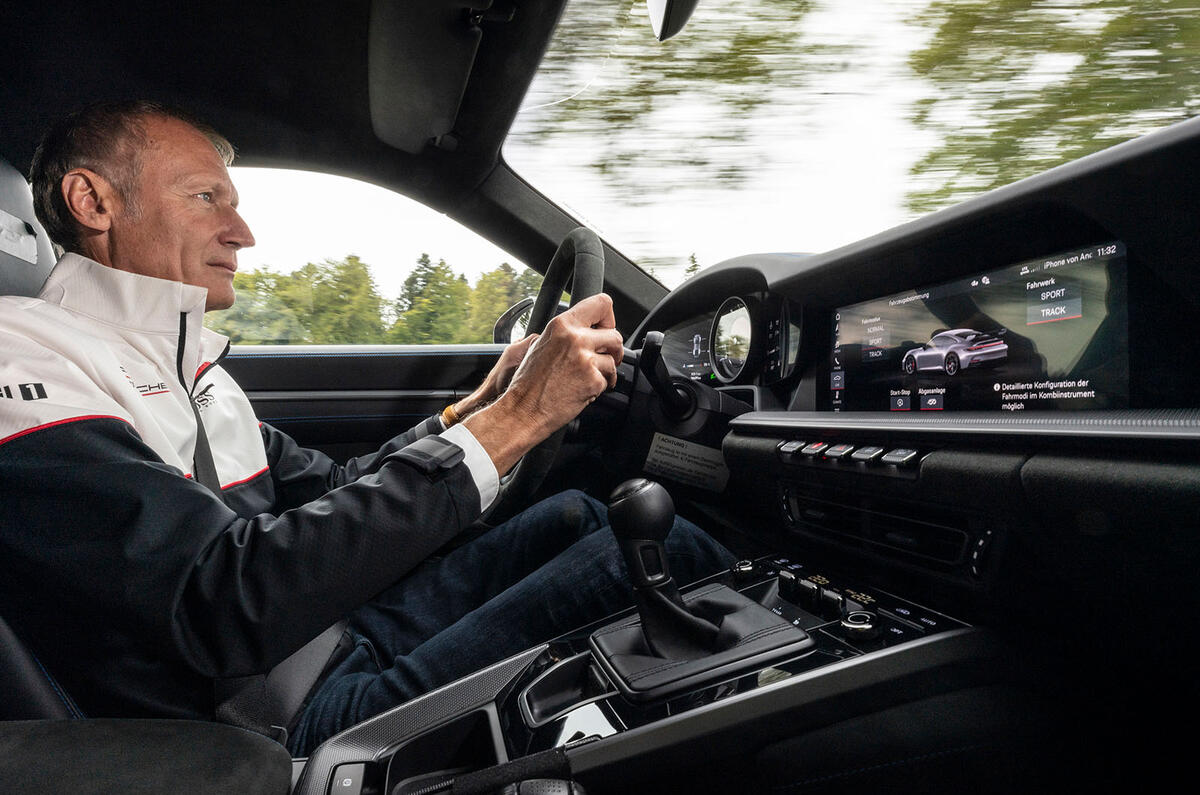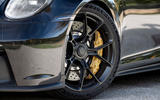The new Porsche 911 GT3 could be the most anticipated car of 2021, as Porsche’s last stand for naturally aspirated, high-revving sports cars.
“It’s a modified Speedster engine,” confirms Porsche’s GT line director Andreas Preuninger. There are differences, because the 992-generation 911 GT3 will have to pass regulations not applicable to the 911 Speedster during its production cycle, but the 4.0-litre naturally aspirated flat six revs to the same glorious 9000rpm.
The output? Preuninger’s saying 503bhp, so the same as the Speedster, and an increase over the previous 991.2 GT3’s 493bhp.
Not a huge bump in power, then, but homologating what’s essentially a racing engine for the road isn’t the work of a moment, especially given ever-stricter regulations around emissions, particulates and sound. They’re so restrictive these days that Preuninger says some 80% of his team’s engineering time is applied just to maintaining the GT3’s level of performance, which leaves the remaining 20% of their efforts for improving it.
The gains this new GT3 will bring are generated elsewhere. Preuninger’s quick to point out, though, that there won’t be any more weight, saying: “I didn’t want the car to be heavier. That was critical. It has to be bigger because I've got the 992 body now, but I don't want to carry more weight.”
Using the usual GT3 mass-reduction route - no rear seats, less sound deadening, lighter materials, thinner glass and, now, a carbonfibre bonnet - the 992 GT3 weighs no more than its predecessor. That’s been achieved without resorting to things like deleting the air-con – which isn’t even possible with the new 992 GT3.

We’re in one of Porsche’s many prototypes and Preuninger is driving on familiar roads around Weissach. He says: “This is a Motorsport car so it has to live up to that expectation.” There’ll be a lap time applied to it when it’s launched, but for now, he’s saying nothing, except, obviously, it’ll be quicker. The improvements, then, are centred around the GT3’s chassis and aerodynamics, with significant changes throughout.
The most obvious visual clue is the aero and, in particular, the rear wing. “It's always form follows function – always, especially here,” he says. The wing apes that of its racing relations, being hung-mounted, creating beneficial, uninterrupted, airflow under it. Usefully, too, it cleans up airflow into the GT3’s engine. There’s a huge diffuser out back as well, a flat underside and airflow-managing and exploiting ducts in the front and underneath – all doing everything they can to force the rushing air to do the job that the GT department wants from it.
It has worked, convincingly, and this GT3 comes with a 50% increase in downforce but without any increase in drag. That’s significant, not just for track speed, but because Preuninger wants the GT3 to be quick at high velocities. “We live in Germany with autobahns and I want it to accelerate heavily until you see a 'three' as the first of the triple digits. After that I don’t care,” he says.
To prove exactly that, part of our route today takes in some derestricted autobahn, where Preuninger emphasises his point convincingly by nudging the transmission-tunnel-mounted PDK stick (Preuninger preferring a stick to paddles, hence its inclusion) to drop some gears and let the 4.0-litre do its thing. The forces it delivers is reminiscent of the Speedster, only the note’s a bit deeper in its tone at lower revs, with the pitch changing and screaming with rousing intensity as it runs to its lofty, 9000rpm redline.

Point proven, Preuninger peels off the autobahn and takes in some familiar, more challenging country roads. It’s here that it’s more revelatory. The ride proves remarkably supple despite the car's clear focus and lack of rubber bushing, something achieved despite it riding on springs 25-30% stiffer than the previous GT3's. Damper tuning is key here, which, Preuninger admits, his team are hugely specialised in. The rear axle is lifted from the 991.2 so it's a multi-link-set up with rear-wheel steering, but the front has changed dramatically and features a double-wishbone layout, with parts picked off the shelves from the Cup and RSR racing cars. “We were not sure if we could get this system into the 911 platform. But we did it and it was worth it,” says Preuninger.
Quicker to react to bumps, there’s less resistance and it’s stiffer and more stable under braking. It feels it, too, the 992, despite its bigger footprint, and it comes across as wieldy and incisive even when you're sitting in the 'wrong' seat. The brakes – 408mm on the front axle and 380mm on the rear – are pitted, rather than through drilled, aping, again, those racers. The front discs sit behind centre-locked 20in alloy wheels, now 9.5in wide up front with 255/35 ZR20s Michelin Pilot Sport Cup 2s. The 21in rear wheels are 12in wide and shod in 315/30 ZR21 tyres.
Inside, there’s GT3 specific instrumentation and drive modes, which have been simplified and reduced to just Normal, Sport and Track, with each being configurable. There is the choice of the seven-speed PDK automatic or a six-speed manual, both offered on the two GT3 derivatives, whether you prefer the overt track-refugee look of the standard GT3 or the quieter sleeper style of the Touring.
On the evidence of a couple of hours in it with the man who’s responsible for it, any choice will be worth waiting for. Preuninger sums it up as well as anyone could: “Emotion is the reason people buy a GT3. It's the enjoyment of driving the car. That's definitely the main driver: to be driving just for the sake of it.” We’ll find out very soon how right he is when we do that for ourselves, but from the passenger seat, it’s difficult to argue with him.
Kyle Fortune
READ MORE
New Porsche 911 Turbo arrives with 572bhp flat six
High-riding Porsche 911 prototype hints at rally-inspired variant











































Join the debate
Add your comment
Wishbone front suspension ? Will be very interesting to see how this has been engineered without loosing luggage capacity .
This is a great car, it may have its faults, but, if your really into the brand, any brand for that matter, you'll put up with it.
Be interested to hear what faults you are familiar with given its as yet unseen and undriven. Please enlighten us?
Not sure if your having a laugh or not. Aside from the frunk, theres ton's of space that the rear seats usually occupy. So the suspension and luggage capacity is moot, and if your average GT3 owner needs luggage space we go in the wifes Cayenne turbo? Simples.
It's gonna be some car. Porsche still offering naturally aspirated engine and manual. I wonder if this will be the last 911 generation to do so. Can't wait for the reviews.